Women make up less than half of global sports fans. But many sports are closing the fan gender gap, some by more than 40% since 2017.

This Sunday marks International Women’s Day, and an opportunity to reflect on and celebrate the massive strides over recent years towards parity for women in the world of professional sports.
While we have seen significant progress in terms of increased female representation on the field and across sports media, increasing (though not consistently equal) pay and prize money, greater sponsor engagement, and sporting feats of individual brilliance by female athletes, the reality is that many sports still attract a predominantly male fan base.
Has the recent increased focus and exposure for women’s sport helped reduce the gender imbalance among sports fans? Are we closing the sports fan gender gap?
There are many positive signs that sports around the world are working to be more accessible and appealing to a wider, more diverse audience. Many sports see this as critical to their long-term sustainability – sports can’t expect to focus on a traditional “pale, male and stale” fan base and hope to grow sustainable revenues, attract new fans, and continue to build participant pathways.
From shorter formats (e.g. T20 cricket), more entertainment around a sporting event (e.g. Formula 1 Grand Prix, Australian Open tennis), and marketing campaigns that speak to different and diverse fan segments, the sports fan experience has become increasingly accepting (and acceptable) for all fans.
But which sports are most balanced in terms of gender among passionate fans? Which have the biggest fan gender gap? And which sports and regions around the world are moving the needle the most to close the gap?
APPROACHING PARITY
If success on gender parity in sports fandom is that the population of sports fans reflects the gender split in the overall population, we should be aspiring to a roughly 50:50 split of males and females among passionate sports fans.
In 2020, according to Gemba Insights global sports fan research, across a basket of 13 of the world’s most popular sports, women make up 47% of highly engaged, passionate sports fans. This is up from 45% three years ago, so the fan gender gap is closing.
However, these figures mask some larger gender gaps in specific sports and regions. A relatively high proportion of female fans in Swimming, Tennis and Volleyball (especially in China) skew the data closer to parity.
Globally, football (soccer) has only 42% of its fan base being female, almost unchanged since 2017 despite the success of the Women’s World Cup tournament, won by the USA, in 2019.
And in key markets around the world, including Australia, the UK, Japan and the US, sports fandom remains largely the preserve of men, although the fan gender gap has closed by as much as 40% in some sports over the past three years.
A NATIONAL SPORT LENS
We might expect that the biggest sports in each country could be the ones that appeal most to female fans; they have more existing fans, more people talk about them and it’s almost impossible to miss them in the media – hence we’d expect the major national sports to be at the vanguard of closing the fan gender gap.
In the US, the fan base of American Football (gridiron) is strongly male dominated, with almost two-thirds of fans being male. Notably, this has not changed since 2017 – the NFL is not closing its fan gender gap. Yet Basketball, starting from the same level as American Football in 2017, closed the fan gender gap in 2020 from 11 percentage points to just 7 points – a 36% reduction in the gender gap to parity in just over three years.
It is no coincidence that Basketball has seen continued growth in both cultural relevance and commercial outcomes during this time (a key commercial lesson to all rights-holders – expand your appeal).
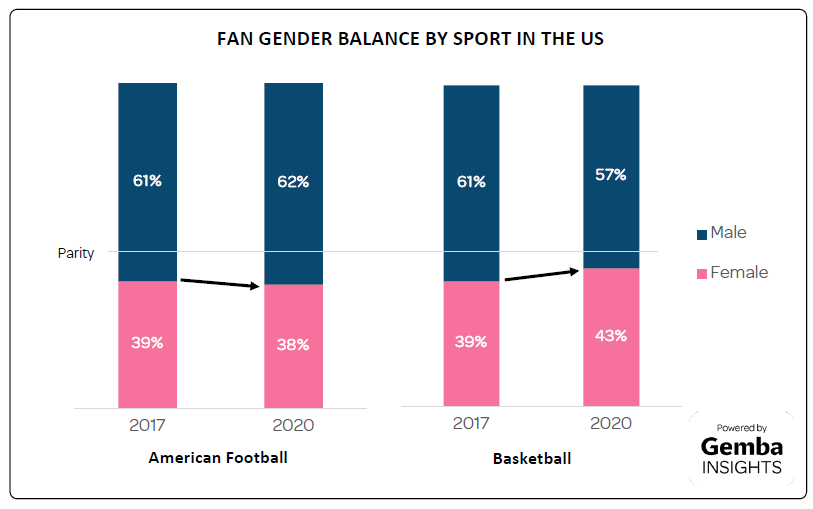
Cricket is a major sport in Australia, India and the UK. As a sport, Cricket has closed the fan gender gap in Australia by 21% since 2017 (from women making up 31% of fans, to 35% in 2020), and by 27% in the UK (from a low base of 28% up to 34% of fans being female). The strength of the local women’s leagues (WBBL, for instance) has contributed greatly to the increasing interest in the sport amongst women. In India, where Cricket is akin to a religion, the gender gap is much smaller – 47% of Cricket fans there are female.
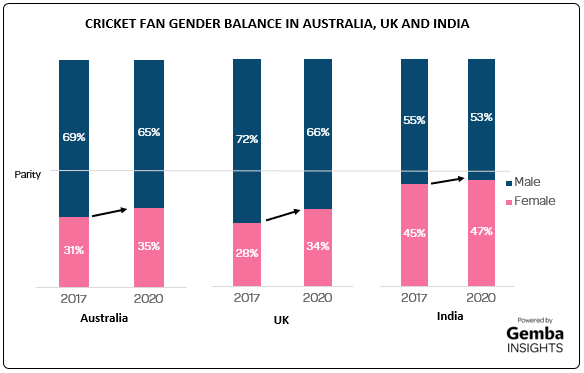
Football is perhaps the sport with the most compelling global story to tell around female engagement over the past few years, with a highly successful World Cup, positive publicity and strengthening women’s leagues around the world. This has led a narrowing of the gender gap in Brazil, the US and the UK.
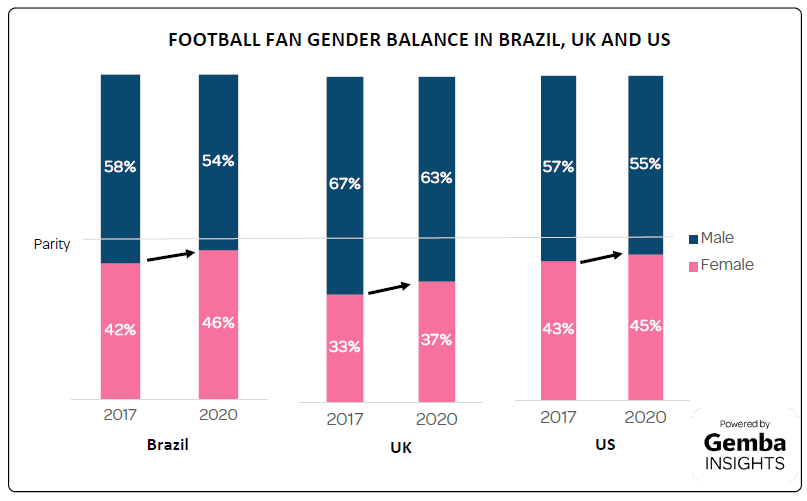
SPORTS BUILDING PASSION AMONGST FEMALES
We’ve observed a number of other patterns emerging from the data. Gemba’s global research in 2017 covered 10 countries (Australia, UK, US, Brazil, China, Italy, Spain, Germany, India and Japan) – though the study has now expanded to 20. When we looked at each country, we largely saw what one might expect given the frequent gender bias reported in sport. While there was an overall male skew, we saw certain sports presenting a larger gender imbalance. American Football, Boxing and Rugby Union present higher skewed fan profiles toward males, while others such as Tennis, Volleyball and Swimming demonstrated a more balanced profile.
And in the three intervening years we can demonstrate some positive shifts in this pattern. In the 13 sports shown in the chart below, the average proportion of female sports fans increased by 3 percentage points closer to parity, and has increased for all sports apart from Swimming and Tennis (two sports that already had an equitable fan gender balance). Rugby Union, Rugby League, American Football and Boxing – largely archetypal male supported sports – all experienced a balance shift in favour of females and closer to parity (though their fan bases remain predominantly male).
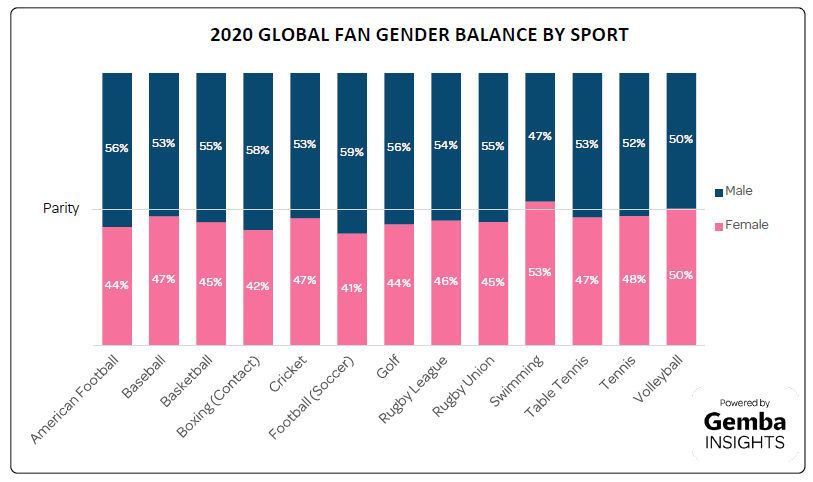
CHANGES BY MARKET
What about the fan gender gap at the country level? In 2017 all countries we analysed apart from China and India had large fan gender skews towards males. The biggest gender gaps were in Australia, the UK, the US and Japan.
When we look at the same countries in 2020, most countries have attracted a larger proportion of females into their fan base. Impressive gains were noted in the UK, the US, Italy (all +5 percentage points closer to parity) and Germany (+6 points closer to parity). In Germany there is an increasing push to include women in sport – and a recognition of previous under-acknowledgement of past achievements. It now honours the country’s best female footballers in a Hall of Fame, and 2020 marks 50 years since a ban on women’s football was overturned in Germany.
The overall shifts noted means that women are increasingly more engaged in sport and express a growing passion toward it.
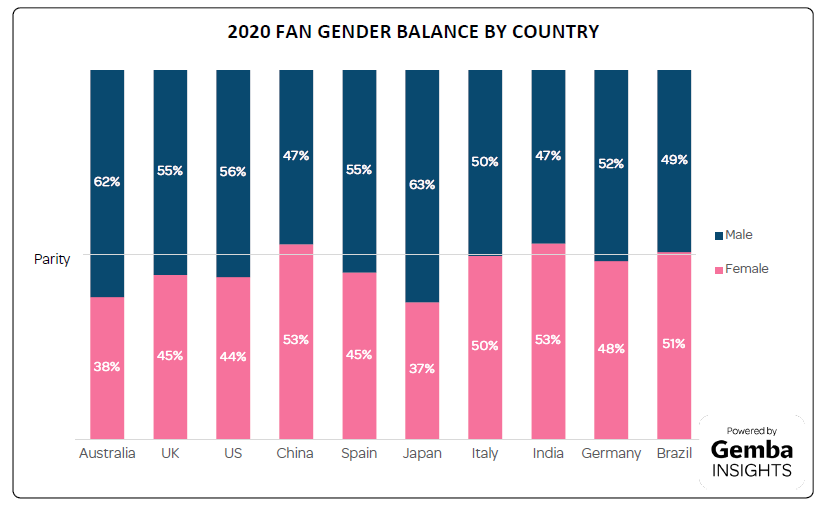
A GENERATIONAL SHIFT
The shift in fan balance is a positive outcome for all the hard work currently being undertaken by the emerging sports stars and administrators alike. Not all women’s sports are achieving the attention of Football or Cricket, yet the perseverance to grow the game needs to be acknowledged.
There are a range of reasons why a person becomes involved in a sport – sometimes it is a parent taking a child to a game; sometimes it’s kids talking about the sport in the playground or simply being unavoidably exposed to it if it’s a national pastime.
But there is one sure way to grow passion for a sport and that is to be able to see yourself in the faces on the sporting field. The last three years has experienced unprecedented growth in female sport, with more leagues and greater exposure and airtime – and we’ve seen the emerging passion of female fans as they can increasingly see female athletes on the playing field.
Those sports that embrace the growth in women’s participation and fandom will continue to build a new, more diverse generation of fans that will sustain the sport for years to come.
Find out more about Gemba’s global sports and entertainment research at www.thegembagroup.com/insights
Research parameters:
- Fandom defined as 4 or 5 on a 5-point self-rated passion scale for the given sport
- Age 16+
- Sample size n=1,000 per country per year
- Surveys conducted in each market October/November 2017 and January 2020